How to get rid of Bats? (Humanely)
 Are you scared of bats? Well, you are not alone. Bats are a serious concern to tons of homeowners. Besides their scary nature, the mess created by bat’s droppings and pungent-smell in their roosting places makes the home unlivable. However, you aren’t allowed to kill them since they are federally protected.
Are you scared of bats? Well, you are not alone. Bats are a serious concern to tons of homeowners. Besides their scary nature, the mess created by bat’s droppings and pungent-smell in their roosting places makes the home unlivable. However, you aren’t allowed to kill them since they are federally protected.
But you can get rid of bats humanely through the following steps.
1. Inspect for signs of bat infestation or damage
Bats can live secretly in your home. Since they are nocturnal, it may take you time to notice their presence until their damage and mess reaches an unreasonable level. Therefore, you should carry out regular inspections for timely action. During your inspection, look for the following.
- Brownish stains or rub marks near the bat’s exit and entry points.
You can also notice brownish stains streaking down the sides of your structure if the infestation is under a barrel tile roof. - Bat guano and pungent ammonia smell.Bats’ feces usually have a pungent odor that might interfere with the air quality in your house when the bat’s colony is enormous. The bats generally leave a pile of droppings in their roosting sites.
- Look for bats exiting at dusk and returning at dawn.Since bats are nocturnal, you can try to observe them leaving your roof or attic at sunset. At times, you can also hear scratching sounds caused by their sharp claws as they crawl and scramble to go through the exit points.
You can also observe a massive swarm of bats around the house to locate their entrance at dawn. When they find their entrance point, they quickly disappear into their roosting area.
After establishing that these ugly mammals roost in your house, either under the roof or in the attic, the next step is to start the removal process. Ready to get rid of the bats? Well, let’s get rolling.
2. Check your local laws and regulation for bat removal
In the US, bats are federally protected since they are among the endangered species of animals. Therefore, it’s illegal to trap or use poisons to kill them. Besides that, the law doesn’t permit interruption of their hibernation and mating periods, even if they could be dangerous to your health. To be on the safe side, check with your wildlife offices.
3. Inspect your attics
Get to your attic and look for the areas with highly concentrated piles of bat’s droppings. Once you find the piles, the bats will be right above the area.
4. Identify the bat species that have invaded your house.
Knowing the type of bats in your house will help you understand their behavior. For instance, some bat species are migratory and just migrate on their own. For such, you only need to wait and then seal their entrances after they leave.
5. Inspect the entry holes and spaces
Get onto a ladder and inspect the entrances. After that, seal all other entry and exit points and then install one-way exclusion devices on main entrances.
There are two types of one-way exclusion devices:
- i. Tube exclusion devices:
The tube should be 2 inches in diameter and 10 inches long. Place the tube less than ¼ inch into the hole to allow the bats to climb out. Also, place a collapsible plastic sleeve at the end of the plastic pipe to prevent the bats from ever getting back in. Alternatively, you can buy Batcone from Amazon for the same purpose. - Netting excluding devices:
It allows bats to slide down to the outside and prevent them from coming back. This device works great on flat surfaces such as shingles, louver, and under window frames. It should be less than 1/6 inches and made up of Polypropylene.
6. Check your devices for 5-7 days.
When all the bats are gone, remove the excluding devices and seal the hole(s) permanently. This prevents a re-infestation.
7. Kick launch the cleaning task.
- Ensure you’re in full protective clothing.
- After that, spray the surface to be cleaned with virucide disinfectant. This destroys any bacteria, viruses, or mold spores that can cause infections.
- With that done, wait for about 10-15 minutes before picking the messes.
- Do not vacuum to prevent spreading odor and making the particles airborne, thereby increasing the chances of infections.
- After removing the mess, spray the infected area with DSV sanitizer
Voila! You’ve successfully saved yourself thousands of bucks through this DIY humane bat
removal. Enjoy a peaceful environment!
HOW TO KEEP BATS OUT OF MY House
Bats are of concern to many homeowners due to the damage and disturbance that they cause. If you’re wary of a bats presence in your home and want to remove them, we’ve made it effortless for you. Below are the steps.
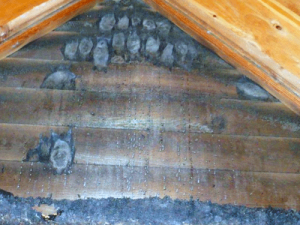
1. Locate bat entry points
Before advancing to any step, locate the entry points that bats use to get into your house.
You can do that through the following:
- Use a ladder to look for openings into your attic and roof since bats love high and quiet areas.
- Observe the bats leaving your house at dusk to know precisely where to inspect
- Inspect the entrances: Bat entrances are always stained with brown oils, grease, guano, and urine.
2. Employ repellants
After locating the entrance points and the roosting area of bats, the next crucial move is to make the condition of their roosting area unfavorable. By doing so, the bats will move out in search of a new roosting place. That’s where repellants come in handy. Below are some of the repellants that you can use.
a. Gel and liquid repellants
These types of repellants contain a variety of non-toxic chemicals that drive the bats off by smell and taste. Usually, you have to re-apply them every 30 days to keep the bats away. Most importantly, always read the manufacturer’s instructions.
b. Ultrasonic repellants
These are devices that emit a high pitched sound that irritates bats while remaining unnoticed by humans. They’re usually fitted with motion detectors that make them turn on only when there is a bat present.
c. Home remedies
These consist of compounds that make the place unlivable or produce an irritating smell that keeps bats at bay. They include:
- Phenols
- Mothballs
- Mylarballs
- Aerosols
- Hang aluminum foil
- Use mirrors
- Use water spray when the bats are asleep. Doing this repeatedly makes them move away.
- Eucalyptus
- Cinnamon: Spray it a couple of times around infested areas.
- Sealants: Use netting and other sealants to prevent the bats from accessing their roosting sites once they go looking for food.
3. Seal off & exclude
Since bats can’t penetrate your home on their own, they’ll always enter your house through the pre-existing gaps. Such entry points include:
- Chimneys
- Behind shutters
- Torn or broken screens
- Open soffits
- Openings such as for pipes and wires
- Under shingle vents, eaves, and sidings
- Holes in the wall
After repelling the bats, prevent them from ever coming back by doing the following:
- Seal off the entrances used by bats leaving only one or two exits.
- On the remaining exits/entrances, install exclusion devices to allow all the bats to get out without getting back to the roosting area.
- With that done, carry out a second inspection to ensure that there are no bats remaining in the roosting site.
- Next, seal off all the possible entry holes, cracks, or gaps.
- Repair other structural faults that may provide entrances for bats into your house.
Note: The use of repellants and exclusion devices is the most effective and recommended
way to get rid of bats in your house. Never kill or trap the bats!
4. Clean the mess
- Before handling the bat’s mess, ensure you’re in full-body protective gear.
- After that, use DSV sanitizer to sterilize the piles of bat droppings and leave it to act for 10-15 minutes before scooping the mess.
- After scraping and scooping off the mess, apply a cleaning solution and scrub the affected surface.
- Dispose of any furniture, carpeting or rugs that cannot be cleaned.
5. Observe preventive measures
Such measure include:
- Regular inspection of your home
- Maintaining exclusion practices
- Creating alternative nests for the bats outside your home With the above steps, you should keep bats out of your house for good.
How to get bats out of my attic?
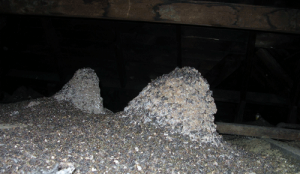
Are you looking for a way to get bats out of your attic? Well, we must have had you in mind. Bats are a problem for virtually every home. Therefore, you aren’t alone. But with the following simplified procedure, you can get rid of bats from your attic pretty fast. Ready to get started? Well, let’s begin.
1. Identify the entrance/exit points used by the bats
Bats cannot penetrate your attic on their own. As such, they look for opportunities. And that’s why looking for their possible routes is pretty crucial. You can do that through inspection. Below are the tips to help you achieve a better result.
- Look for openings on your roof and in your attic.
- Observe the movement of the bats out of the building in the evening as the sun sets. This will help you streamline your effort and focus on certain parts of the building.
- Use a ladder to get into the attic and inspect the dark corners using a portable flashlight.
When doing the inspection, look for brown stains, piles of guano, and a strong ammonia smell around the entrance points.
2. Employ repellants
After locating all the entry routes into your attic, the next crucial step is to introduce repellants into the attic to make the place unfavorable for the stubborn animals. Some of the repellants that you can use include:
- Mothballs
- Ultrasonic sound
- Ammonia
- Bright lights or strobe lights
- Sealing off the attic
Note: Traps are not recommended as they may kill the trapped bats.
3. Seal off the routes and fit the exclusion devices into major entrances or exits
With the repellants in your attic, the bats will begin to scramble out. To prevent them from coming back to the attic, the following steps are key.
- Seal off all the loopholes that bats can use to come back to the attic and leave their main entrances/exits for exclusion device installation.
- Repair the roof of your house and any other part that can allow the entry of bats into your attic.
- With that done, install the exclusion devices in their main entrances to allow them to go without getting back into the attic.
- After that, go for another round of inspection to find out if there is any bat entrance route left. During the inspection, find out if some bats are remaining. If you find some bats, you’ll have to wait for a while for them to get out. If there’s no bats left, head to the next step.
- Remove the excluders and seal off the holes permanently.
4. Clean the mess in the affected areas
Since bat messes may contain some deadly viruses, ensure you’re in full protective gear before you get to the attic. After putting on protective gear, follow the steps below.
- Apply a liquid disinfectant and wait for 10-15 minutes before removing the piles of droppings.
- Shovel the guano and put them into a collection bag.
- Scrape the stuck droppings
5. Maintain regular inspection and monitoring
Keep checking your home for any sign of a bat invasion to help address the bat problem before the situation gets out of hand.
Note: Eradicating a swarm of bats plaguing in your home may not be easy through a “do it yourself” method. In such cases, always contact professional wildlife removal experts.
HOW TO KEEP BATS OUT OF MY CHIMNEY
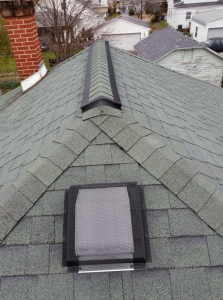 Bats are small nocturnal animals that roost in dark, cool and enclosed places. This is why chimneys and attics are perfect living places for bat colonies. These small winged creatures are really harmless, but they can be a nuisance and their awful-smelling droppings are laced with pathogenic microorganisms.
Bats are small nocturnal animals that roost in dark, cool and enclosed places. This is why chimneys and attics are perfect living places for bat colonies. These small winged creatures are really harmless, but they can be a nuisance and their awful-smelling droppings are laced with pathogenic microorganisms.
It’s unsafe to have bats anywhere around your home, especially in large numbers. If you notice that there are bats in your chimney and would like to get them out for good, there is only one proven way to do that successfully and that is through bat exclusion and sealing. In your quest to rid your chimney of bats, you may have come across bat repellents and ultrasonic high-pitch sound achines, and it is safe to say that they aren’t very effective. Your best bet to permanently eliminate bats from your chimney is by doing a bat exclusion following the steps described below.
Find the entry points the bats use and seal off the holes
The first step towards eliminating any traces of bats from your chimney is to do a thorough inspection and identify all the holes and cracks from where these night crawlers get in. During the day, check for obvious entry points for your unwelcome guests. Look for signs like broken shingles, holes and cracks in soffits, gaps between the chimney and the roof, and watch out for bat tracks like brown stains, droppings, or bat smells around these cracks. While a daytime inspection may seem like a great idea, you should know that bats can squeeze in through holes and cracks as tiny as 0.3 inch (0.76 cm), this means you’ll be more likely to miss these very tiny cracks during the day. So, you also need to do a thorough night search.
Since bats are nocturnal creatures, they fly out at night to forage. By watching your chimney at night, you can see where they exit and enter. This will show you the areas to concentrate on during your inspection. As these bats fly out to forage, move in and look for the cracks and holes they exited through, use a reliable sealant to seal off every crack and hole you find.
Unfortunately, if you have a large colony of bats in your chimney, not all of them will leave at once to forage. While some are gone, a few others may stay behind and this brings us to the next step.
Evict your bothersome tenants using an exclusion device
Your next step toward getting rid of these dreadful creatures is by installing an exclusion funnel or netting. An exclusion device will allow the bats to exit the building and once they’re out, they can’t get back in. This is the absolute best method to effectively get rid of bats from your home.
You can get an exclusion device from any home improvement or pet store around you. Once you install it, carefully watch as the remaining bats in your chimney fly out and never return. You can watch for 3 nights in a row to ensure they have all left. If you observe that the bats are completely gone, remove the exclusion device and seal off the chimney.
Make your home bat-proof
To completely rid your home of bats and successfully keep them out, you’ll have to make your home bat-proof. If you don’t do this, those bats will be back in the near future, bringing you back to square one. Unlike rodents, bats can’t chew their way into your home. If there are no cracks and holes, they can’t come in.
To permanently keep them out, make sure you seal every crack and hole in your chimney and attic, and use a tiny-mesh netting to cover areas that cannot be sealed. After the exclusion, those bats will definitely return, but if they can’t find their way in, then they’ll find somewhere else to call home.
Clean up afterwards
After the exclusion comes thorough cleanup. You’ll need to get rid of all traces of bats and their remains from your chimney to avoid attracting other animals. Thorough cleanup will get rid of bat droppings (guano), dead bats, and the awful smell of bat urine. Be very careful while doing this as bat urine and feces contain disease-causing microorganisms. It’s advisable that you wear rubber gloves and a face mask to protect yourself from possible infection.
Wrapping Up
Effectively getting rid of bats from your chimney can be very tricky, and if done incorrectly, you’ll have the bats back and well established in no time. If you’ve tried following the steps above but still couldn’t successfully get them to stay away, then you may have to contact a pest/wildlife control specialist to do a professional bat exclusion.
How to keep bats from getting into your house
Those small flying creatures that appear to be more like winged mice than birds are actually not as bad as they look. Bats can be very creepy and a nuisance, but they are quite good at minding their business, and they won’t attack or try to hurt you. But, this doesn’t make it less uncomfortable to have bats living in your home, and by any means possible it’s much better to keep them out. Even though bats are harmless creatures, they can still bring diseases into your home. Bat droppings (guano) carry the spores of a fungus which causes lung disease in humans.
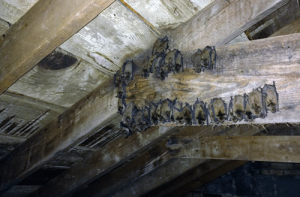 Histoplasmosis is a lung infection that is caused by inhaling guano, this infection is usually not severe but in rare cases it may lead to loss of vision. Bats also carry rabies, a virus that can cause inflammation of the brain. You don’t want such creatures in your home now, do you?
Histoplasmosis is a lung infection that is caused by inhaling guano, this infection is usually not severe but in rare cases it may lead to loss of vision. Bats also carry rabies, a virus that can cause inflammation of the brain. You don’t want such creatures in your home now, do you?
Unfortunately, bats don’t wait for an invitation before they make anyone’s home their roosting place. Anywhere that is conducive enough and easily accessible to them is quickly converted to a breeding place. They love dark, cool, and high places which is why you can find bat colonies living in chimneys and attics. Making your home unattractive to bats is much easier than trying to evict an established colony in your attic. Here are 3 ways to keep bats from getting into your house.
Seal off the Chimney
Bats don’t magically appear in your home, they crawl in through small cracks and holes and establish themselves in chimneys and attics. Therefore, to make your home bat-proof, you’ll need to do a thorough inspection to find all cracks and holes that can act as potential entry points for bats and seal them off using a reliable sealant.
Look for cracks between the walls and the roof, missing shingles, and small holes on soffits. This inspection should be done on not just the chimney, but also the attic, basement, vents and other dark and cool places that can attract bats. Areas that cannot be blocked with a sealant should be covered with a tiny mesh netting. Fortunately, bats don’t do any chewing like rats, so you can simply keep them out by sealing off your home.
Light up the attic
Although bats are nocturnal animals they can also see quite well during the day. But they enjoy cool and dark places for roosting and breeding. These creatures are attracted to enclosed and dimly-lit places, it’s no wonder large bat colonies can live in attics and chimneys.
If your attic and basement are well-lit with bright floodlights with no dim or dark corners, this will be uncomfortable and unattractive as roosting or breeding places for bats. This way, you won’t have bats coming in to live. Lighting up your attic and basement may seem extreme and surely you’ll have to pay more for electricity, but it’s worth the price to pay for a bat-free home.
Heat up chilly corners
Noticeably, bats don’t only like dark places. Their ideal roosting place has to be dark and cool, which brings us to heat. If you’d like to keep your home bat-free at all costs, then consider using heat to keep them at bay. Install small heaters on the walls of your chimney, attic, basement, and other places that can act as a shelter for bats. You don’t need to overheat the entire house, this can be uncomfortable and dangerous, just a little above 100°F will be fine. Further, you don’t have to heat up your walls every day, using heat to prevent bat infestations only requires that you dry up damp walls and keep them moisture-free.
Wrapping Up
Bats are not harmful creatures, they mind their business and are only searching for places to roost and breed. However, having them in your home will expose you to their disease-filled droppings and the creepy noises they make, not to mention the awful smell of their urine. It’s really not nice to have bats in your home and a bat colony in your attic or chimney can be more than just a nuisance, it can be a serious problem and making your home bat-proof and unattractive to them will keep them out.
How to make my property less attractive to bats?
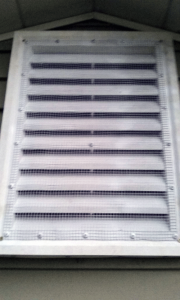
Bats can be a real nuisance when in your home. They create noises such as squeaking, scratching and scrambling among others. These creatures are also known carriers of rabies. This makes them a threat to both you and your pets. It is therefore important to make your home as unattractive to them as possible. Below are some of the ways through which you can do just that.
Chemical Bat Repellents
Naphthalene is the only chemical registered by the Environmental Protection Agency as a bat repellent for indoor roosts. It should be applied across the floor or between walls, using about 2.3 kg for every 60 meters cubed. This should be enough to treat an average attic. As the flakes vaporize, bats get repelled due to the strong odor. However, they return when the smell dissipates. This method needs constant reapplication and is best used in confined air spaces. Humans should avoid inhalation of this chemical.
Illumination
Bats get really disoriented by lights since they are nocturnal creatures. Floodlights strung in areas most likely to be inhabited by bats, such as attics, cause bats to avoid that area. In an experiment, the bat colonies in the roofs of houses decreased by up to 90% when they were subjected to constant illumination. However, two unlit control colonies increased by 57% and 97% respectively. Illumination is cleaner than other methods and safer for both humans and bats.
Drafts
In open spaces, the area may be made more uninhabitable for bats if it is possible to open windows and doors to create drafts. Carefully directed breezes produced by electric fans are effective in successfully repelling bats. However, permanently venting an area or adding a window may make a structure less attractive to bats in the future in case new entry points develop.
Contact Repellents
Sticky-type repellents such as Tanglefoot, rodent glue boards and Tacky Toes can be used in situations where bat accesses and roost surfaces may be coated. These glue substances from time to time accumulate dust and cause them to lose their tackiness. They therefore have to be replenished over time in order to be effective. These repellents limit the movement of these creatures, therefore making the area much less attractive to them.
Alarm and Distress Calls
Distress cries of bats are effective in attracting other bats to nets or traps. According to an experiment done by Fenton et al. in 1976, bats seemed to respond to the cries of their own species as opposed to others. It is therefore important to note the types of species found near your area, therefore customizing the sounds in order to keep them away or trap them.
High-frequency Sounds
This is used to repel or disperse bats. Bats are blind creatures which heavily rely on their echo sounders to locate objects. The high-frequency sound waves interfere with the bats’ ability to navigate, thus disorienting them. It is a good way to make your home less attractive to bats because it makes them avoid areas with agitating sounds.
